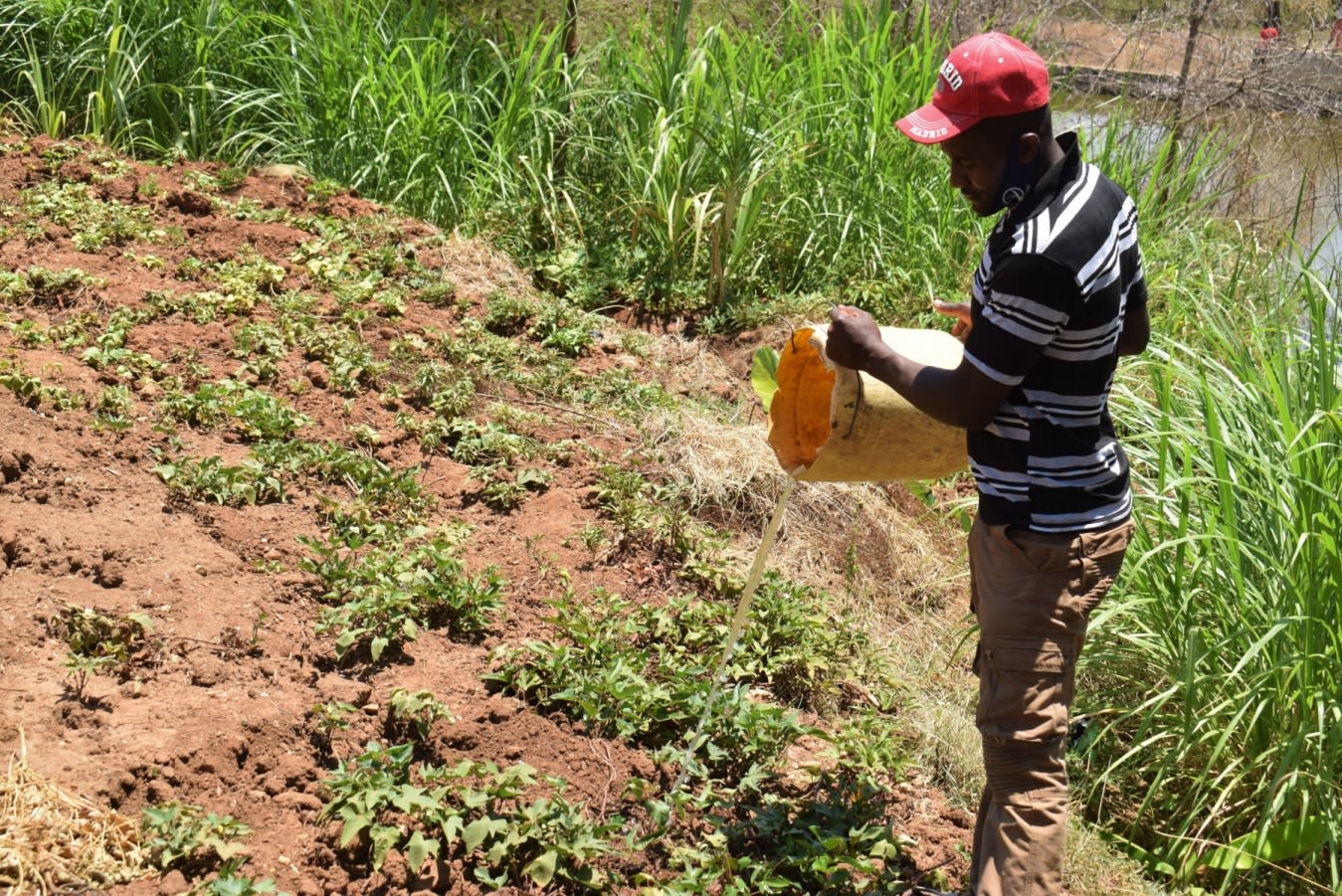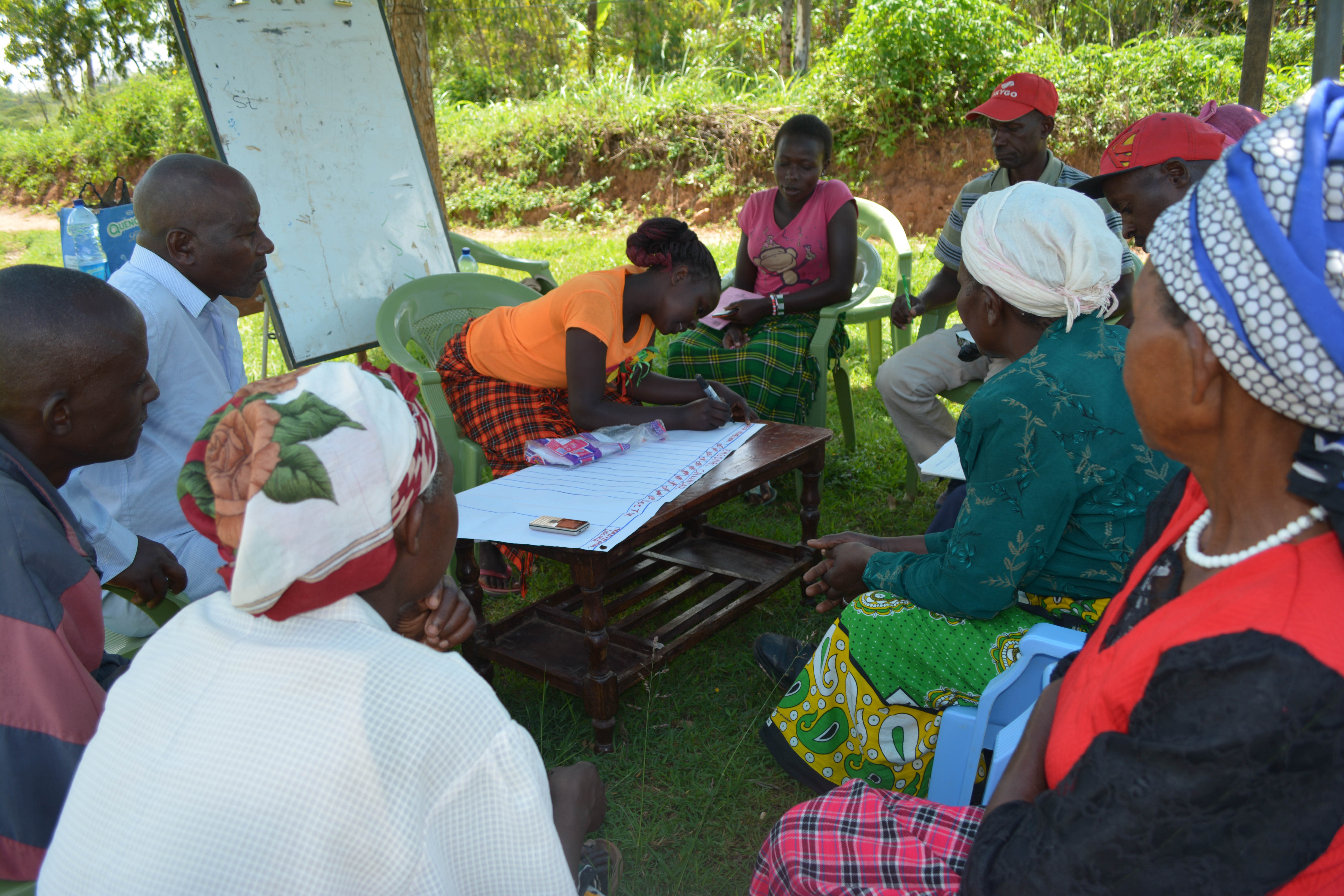Project Updates
October, 2020: Through Their Eyes: COVID-19 Chronicles with Matthew Mulandi
This post is part of a new series by The Water Project meant to highlight the perspectives and experiences of the people we serve and how the COVID-19 pandemic is impacting them. We invite you to read more of their stories here.

Matthew Mulandi and his family.
Our team recently visited Kithumba community to conduct a COVID-19 prevention training and monitor their well and dam. Shortly after, we returned to check in on the community, offer a COVID-19 refresher training, and ask how the pandemic affects their lives.
During this most recent visit, Matthew Mulandi shared his story of how the coronavirus is impacting her life and his community.
Field Officer Lilian Kendi met Matthew outside his home to conduct the interview. Both Lilian and Matthew observed physical distancing and other precautions throughout the visit to ensure their health and safety. The following is Matthew's story, in his own words.
What is one thing that has changed in your community since the completion of the water project?
"A lot has changed since the installation of this water point. We have plenty of water to plant trees and vegetables such as kales, spinach, onions, and tomatoes for domestic use at our homes and sale. Generally, farming projects have intensified thanks to this water project. Community members no longer have to walk for long distances to fetch water. This has enabled them to save more time to engage in other income-generating activities."
How has having a clean water point helped you through the pandemic so far?
"Having a clean water point has helped us provide water for drinking, bathing, washing clothes, and other household uses at our homes."

Since the outbreak of COVID-19 in Kenya, has fetching water changed for you because of restrictions, new rules, or your concerns about the virus?
"Yes, a lot has changed for me since the outbreak of COVID-19. Following the restrictions provided by the government, I have had to practice handwashing before and after using the shallow well's hand pump, observe social distancing at the well to avoid contact, and wear a mask whenever I leave the house to go and fetch water."
How has COVID-19 impacted your family?
"The economy has become unstable since the onset of the virus. Casual labor jobs are not well paying as they were before, which has reduced the income earned at the household level. I had to send my wife and family to live with the extended family at my matrimonial home due to the changing times as I could not provide for them as consistently as I did before."
What other challenges are you experiencing due to the COVID-19 pandemic?
"Our income is unstable due to the lack of jobs. The economy is still rocky hence making it hard for us to engage in businesses as usual. My daughter was to join school this year, but that is not possible due to its closure."

Matthew watering his farm with water from the well.
What hygiene and sanitation steps have you and your community has taken to stop the spread of the virus?
"We took the following hygiene and sanitation steps to stop the virus: wearing masks, social distancing, washing hands with soap and clean water, and avoiding crowded places."
Like most governments worldwide, the Kenyan government continues to set and adjust restrictions both nationally and regionally to help control the spread of the virus.
What restriction were you most excited to see lifted already?
"There were age restrictions set when going to church, but they have been lifted, which has allowed all age groups to attend church. The elderly can now provide counsel to the young generation. The opening of the marketplace has allowed businesses to start picking up gradually."

Matthew Mulandi
What restriction are you still looking forward to being lifted?
"I look forward to the opening of schools so that my daughter can officially join pre-school."
When asked where he receives information about COVID-19, Matthew listed the radio and our team's sensitization training.
What has been the most valuable part of the COVID-19 sensitization training you received from our team?
"Through this sensitization training, I learned the importance of handwashing at all times, social distancing, and proper hygiene and sanitation."

May, 2020: COVID-19 Prevention Training Update at Kithumba Community
Our teams are working on the frontlines of the COVID-19 pandemic. Join us in our fight against the virus while maintaining access to clean, reliable water.

We are carrying out awareness and prevention trainings on the virus in every community we serve. Very often, our teams are the first (and only) to bring news and information of the virus to rural communities like Kithumba, Kenya.
We trained community members on the symptoms, transmission routes, and prevention of COVID-19.
Before there were any reported cases in the area, we worked with trusted community leaders and the Water User Committee to gather community members for the training. At the time, social distancing was a new concept and one that challenges cultural norms. Although community members were hesitant to adopt social distancing during the training, we sensitized them on its importance and effectiveness in combating the spread of the virus
We covered essential hygiene lessons:
- Demonstrations on how to build a simple handwashing station
- Proper handwashing technique
- The importance of using soap and clean water for handwashing
- Cleaning and disinfecting commonly touched surfaces including at the water point.

We covered COVID-19-specific guidance in line with national and international standards:
- Information on the symptoms and transmission routes of COVID-19
- What social distancing is and how to practice it
- How to cough into an elbow
- Alternative ways to greet people without handshakes, fist bumps, etc.
- How to make and properly wear a facemask.

During training, we installed a new handwashing station with soap near the community’s water point.
Due to the rampant spread of misinformation about COVID-19, we also dedicated time to a question and answer session to help debunk rumors about the disease and provide extra information where needed.
Water access, sanitation, and hygiene are at the crux of disease prevention. You can directly support our work on the frontlines of COVID-19 prevention in all of the communities we serve while maintaining their access to safe, clean, and reliable water.

February, 2018: Kithumba Community Hand-Dug Well Complete
Kithumba Community, Kenya now has a new source of water thanks to your donation. A new hand-dug well has been constructed adjacent to a sand dam on a local river. The dam will build up sand to raise the water table and naturally filter water. Community members have also attended hygiene and sanitation training, and plan to share what they learned with their families and neighbors. You made it happen, now help keep the water flowing! Join our team of monthly donors and help us maintain this hand-dug well and hundreds of other projects.
Project Result: New Knowledge
The field officers worked closely with the self-help group chairman to arrange for hygiene and sanitation training. They wanted the best dates to ensure the attendance of all group members. Even community members who weren't a part of the self-help group were invited to attend. We all met at Justine Daudi's homestead, where group members constructed an awning for shade.

In the first session, we had the participants share their expectations. What was it that they wanted to learn about most? Participants shared that they wanted to learn how to prevent waterborne disease, more about personal hygiene, and how to work better with their group.

Two ladies take part in a role play that teaches the importance of working together
We also taught about hand-washing; when to wash, how to wash, and how to build a hand-washing station.

We compared and contrasted different daily habits and how they impact health. Many people were participating in the spread of germs and didn't even know it. The participants were active in their learning, and were dedicated to putting together an action plan to implement everything they learned.

To cap it all off, we taught group members how to make soap. This will not only help each household to stay clean, but will give them an opportunity to earn money by selling the soap.

Mr. Nzunga said, "The training was very good. I have learned a lot of new things. I learned about latrine hygiene and I will build a better pit latrine at home. My family doesn’t know how to wash hands. Once I get home I will teach them on the method I learned here. I wish my wife attended the training too, but I will try to train her on the details of this training. I also learned about diseases and how I can prevent them."

Project Result: Hand-Dug Well
We delivered the experts and materials, but the community helped get an extraordinary amount of work done. They collected local materials to supplement the project, including sand and water.
A hole seven feet in diameter is excavated up to a recommended depth of 25 feet. (Most hand-dug wells don’t reach that depth due to the existence of hard rocks between 10-18 ft.).

The diameter then shrinks to five feet when construction of the hand-dug well lining is completed. This lining is made of brick and mortar with perforations to allow for water to seep through. As sand builds up around the well walls, it will naturally filter the rainwater that’s stored behind the dam.

Once the construction of the lining reaches ground level, a precast concrete slab is laid on top and joined to the wall using mortar. Four bolts for the hand-pump are fixed on the slab during casting. The mechanics arrive to install the pump as community members watch, learning how to manage and maintain the pump for themselves. The well is then given a few days after installing the pump, allowing the joints to completely dry. After it rains, communities are advised to pump out the first water that seeps into the well because it often has a foul smell and a bad taste. After pumping that for a while, the water becomes clean and clear.
Mr. Nzunga said, "We had a big water problem in our area. I used to have to walk for two kilometers in search of water, but after we constructed the sand dam and well I just have to walk for 200 meters to fetch water. We are happy and grateful for the new source. We have plans to plant fruits and vegetables using the water in the dam." This hand-dug well was built simultaneously with its adjacent sand dam (to see the sand dam, click here). The sand dam will collect sand that stores and filters huge amounts of water, water that will then be accessed safely through the pump.

November, 2017: Kithumba Community Hand-Dug Well Underway
Kithumba Community in Kenya will have a clean source of water, thanks to your generous donation. A new well is being constructed adjacent to a new sand dam, and the community will attend a review on important sanitation and hygiene practices. Together, these resources will go a long way in stopping disease, hunger, and thirst in the area! We just posted a report including community details, maps, and pictures. We will keep you posted as the work continues!


 Protected Dug Well
Protected Dug Well
 Rehabilitation Project
Rehabilitation Project



































